It’s time to stop fighting your backyard. You crave fresh, homegrown flavor, but the thought of a sprawling, disorganized vegetable patch feels more like a chore than a delight.
That’s the common plot twist in the garden story: a desire for lush harvests meets the reality of weeding, messy rows, and wasted space. Your aching back and disappointing yield are signals that it’s not a lack of effort, but a lack of inspired design.
A vegetable garden shouldn’t just produce food; it should be a beautiful, efficient extension of your home. As a design expert, I see your garden’s potential not as another plot of dirt, but as a tailored outdoor room.
This isn’t about traditional rows; it’s about smart, space-saving layouts, vertical growth, and combining aesthetics with abundance. Get ready to transform your growing space from an unruly mess into your favorite, most fruitful corner.
Starting a vegetable garden can be a deeply rewarding experience, transforming your outdoor space into a source of fresh, healthy produce. The key to success lies in choosing the right methods and plants for your specific space and climate.
Here is a full guide to vegetable garden ideas, covering everything from design and structure to plant selection and key techniques.
1. Choosing Your Garden Style and Structure
The “perfect” garden structure depends entirely on your available space, personal mobility, and aesthetic preferences.
1. Raised Garden Beds (Pictured: Raised-Bed Bliss)
These are a fantastic option for beginners and experienced gardeners alike.
- Benefits: Raised beds offer superior drainage, warm up faster in spring, and allow you to control the soil composition entirely. They also reduce strain on your back and knees.
- Design: Construct frames from untreated wood, stone, or metal. Beds should be no wider than 4 feet so you can easily reach the center from any side without stepping on the soil.
2. Container Gardening (Pictured: Compact Container Crops & Galvanized Goodness)
A wonderful solution for urban dwellers, patios, balconies, and small yards.
- Benefits: Containers are portable, allowing you to move sun-loving plants to the best location. They are highly flexible and can be very decorative.
- Vessels: You can use terracotta pots, old barrels, five-gallon buckets, or even stylish galvanized tubs. Remember, larger containers are easier to manage as they hold moisture longer. Always ensure good drainage holes.
- Crops: Tomatoes, peppers, leafy greens (lettuce, spinach), radishes, and herbs thrive in containers.
3. Vertical Gardening (Pictured: Enchanting Edible Archway)
This method maximizes small spaces by growing plants upward along a wall or structure.
- Benefits: It significantly increases growing area, keeps fruit and leaves off the ground (reducing disease), and adds unique architectural elements to your garden.
- Structures: Use trellises, arbors, cages, and stacking planters (ladders or tiered stands). A simple A-frame trellis or cattle panel archway can turn a walkway into a productive, beautiful feature.
- Crops: Vining vegetables like cucumbers, pole beans, peas, some squash varieties, and indeterminate tomatoes are excellent for vertical support.
4. Traditional In-Ground Beds (Pictured: The Abundant Row Garden)
For those with larger yards and good existing soil, in-ground planting is a straightforward choice.
- Design: Plant vegetables in rows or blocks. If planting rows, orient them North to South, arranging taller plants on the north side to avoid shading shorter crops.
- Technique: Consider an intensive gardening style, planting crops closer together to shade out weeds and maximize yield in the space.
2. Essential Garden Planning and Techniques
Creating a successful vegetable garden involves more than just planting seeds. Thoughtful techniques ensure health and a continuous harvest.
1. Site Selection and Soil
- Sunlight: Most vegetables need at least six to eight hours of direct sunlight each day. Leafy greens can tolerate a little more shade.
- Soil is King: A healthy garden starts with healthy soil. Enrich your soil with plenty of organic matter, like compost and aged manure, to improve fertility and texture.
- Preparation (Pictured: Prepared Raised Beds): Before planting, till your garden and amend the soil. For new raised beds, fill them with a quality mix of compost, topsoil, and vegetable-specific growing mix.
2. Layout and Spacing
- Square Foot Gardening: This popular method divides raised beds into one-foot squares, assigning a specific number of plants to each square based on its size needs (e.g., 1 tomato plant per square, 16 radishes per square). This maximizes space efficiently.
- Pathways: Ensure all garden beds have paths wide enough to easily walk, weed, and harvest without stepping on the soil, which causes compaction.
3. Planting Strategies for Abundance
- Cool-Season vs. Warm-Season: Only plant warm-season crops (tomatoes, peppers, corn) after the danger of frost has passed and the soil has warmed. Plant cool-season crops (lettuce, kale, peas, radishes) in early spring and again in the fall.
- Succession Planting: Plant small batches of quick-maturing crops, like lettuce or radishes, every two to three weeks. This prevents all your harvest from ripening at once, ensuring a steady supply over the season.
- Companion Planting: Grouping certain plants together can benefit their growth. For example, basil is said to improve the flavor of tomatoes and repel pests. The famous Three Sisters method combines corn (a trellis), beans (add nitrogen to the soil), and squash (ground cover to suppress weeds).
4. Watering and Feeding
- Watering: Containers and raised beds dry out faster than in-ground plots; they require more frequent attention. Water deeply and consistently, especially during hot, dry spells.
- Feeding: Vegetables are heavy feeders. Supplement your rich soil with a balanced, slow-release or liquid fertilizer during the growing season to ensure continuous production.
3. Easiest Vegetables for Beginners
Start your gardening journey with varieties known for being forgiving and high-yielding.
- Leafy Greens: Lettuce, spinach, kale, and Swiss chard are fast-growing and can often be harvested a few leaves at a time, encouraging more growth.
- Root Vegetables: Radishes, carrots, and beets are great for direct seeding and mature relatively quickly.
- Legumes: Bush beans and pole beans are easy to start from seed and produce prolifically.
- Summer Staples: Cherry tomatoes and zucchini are incredibly productive; start small, as just a few plants can feed a family.
1. Garden Bed And Soil Preparation
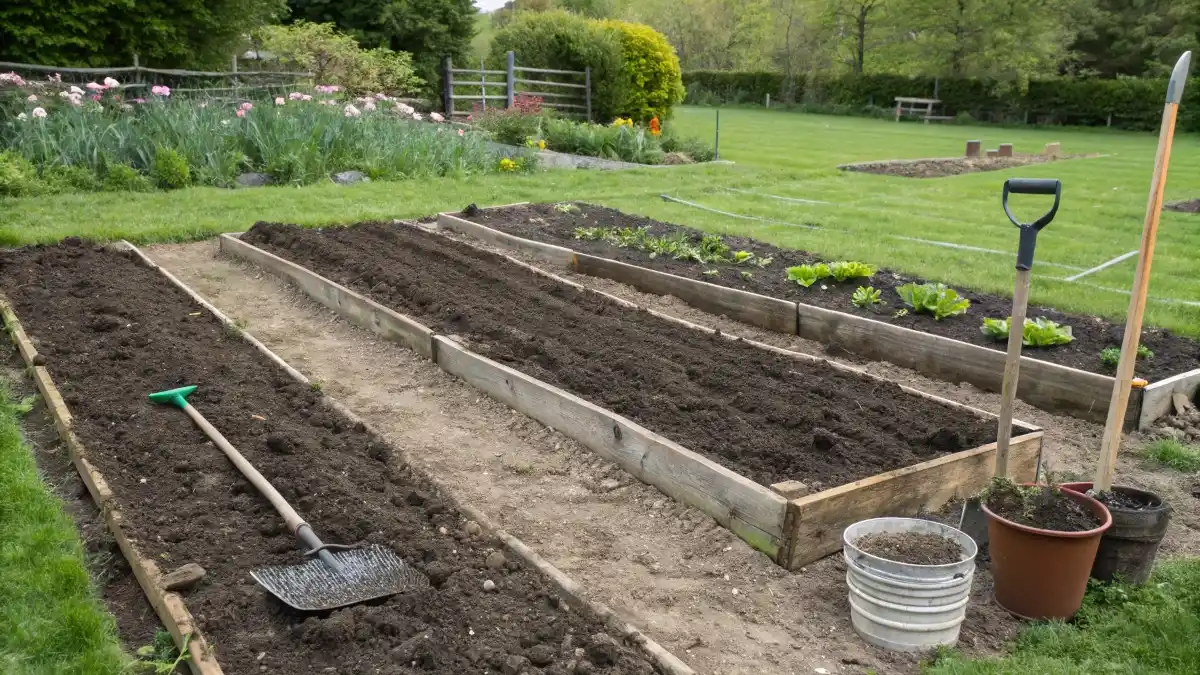
Spring vegetable garden, featuring several well-prepared raised beds awaiting their new plants. In the foreground, rich, dark soil has been meticulously tilled and mounded, ready for seeds or seedlings.
A sturdy wooden frame defines one of the beds, offering excellent drainage and easier access for gardening tasks. A garden shovel and a spade lean against the wooden edge, alongside buckets and pots, indicating recent work and ongoing preparation.
Further back, another raised bed already hosts young, green lettuce plants, showing promising growth. The surrounding landscape includes a lush green lawn and flowering borders in the distance, establishing a serene backdrop for this productive space.
This scene embodies the anticipation and effort that goes into creating a thriving vegetable patch, promising fresh produce in the seasons to come.
2. Raised-Bed Bliss
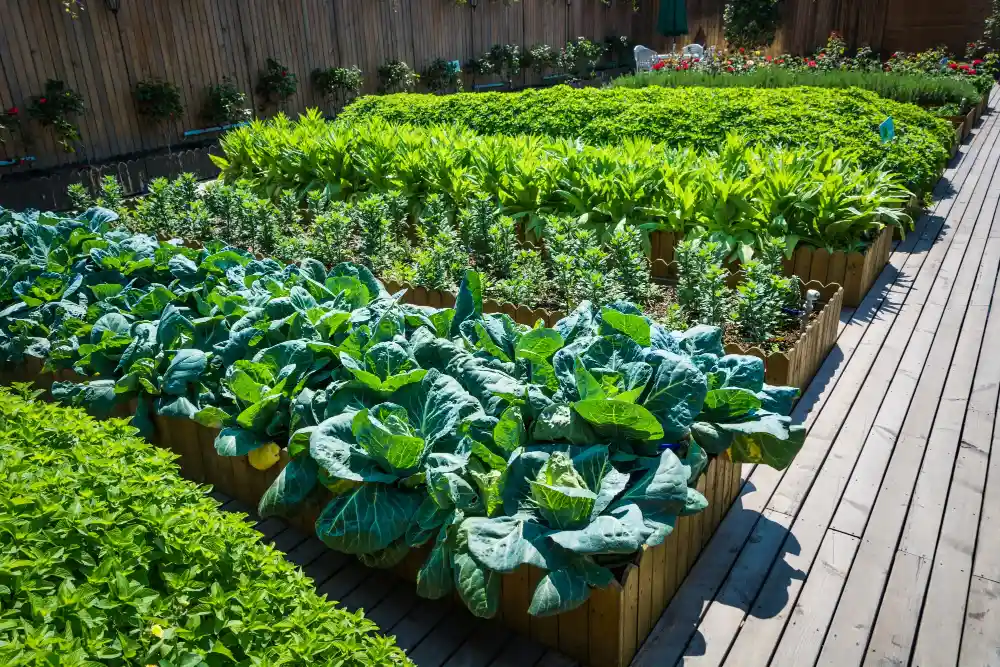
A beautiful backyard vegetable garden comes to life in this sun-drenched image, showcasing the simple elegance and efficiency of raised garden beds.
Large, lush cabbages with their thick, crinkled leaves dominate the foreground, thriving in a well-defined wooden box. These robust containers keep the garden tidy and make tending to the plants a breeze, a smart solution for any home grower.
Beyond the cabbages, you see rows of vibrant, green foliage extending further back, suggesting a diverse and bountiful crop. A neat wooden fence provides a pleasant backdrop, giving the garden a private, organized feel.
The clean, light-colored wooden deck running alongside the beds adds to the aesthetic appeal, making this space an inviting outdoor haven.
3. Tiered Stone & Sun-Kissed Veggies
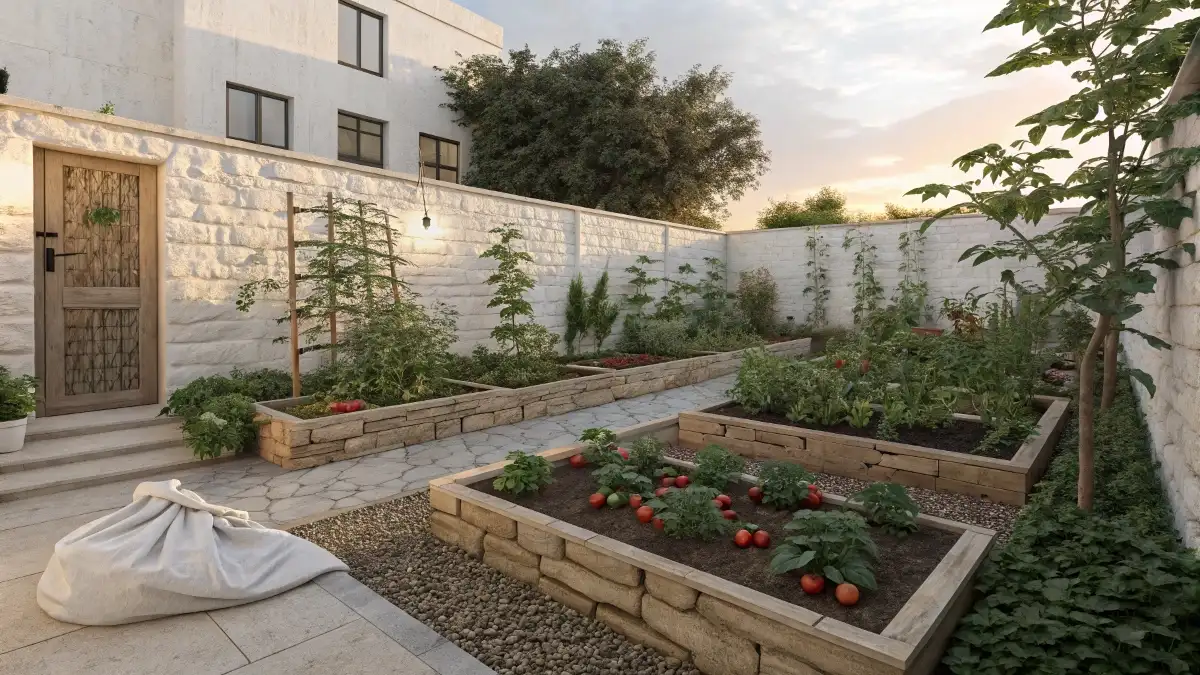
Charming backyard vegetable garden, skillfully designed with tiered raised beds constructed from natural stone. The warm evening light bathes the scene, highlighting the flourishing tomato plants laden with ripe, red fruit, promising a fresh harvest.
These elevated beds make gardening accessible and organized, creating distinct growing zones for various plants. A sturdy stone wall frames the garden, offering a sense of enclosure and privacy.
Overhead, a single hanging light adds a touch of rustic charm, suggesting this space is enjoyed into the twilight hours. The paved pathways and gravel accents provide a clean and navigable layout, enhancing the garden’s overall neatness.
A small tree stands tall against the wall, adding a vertical element and some natural shade. This garden blends functionality with aesthetics, proving that even compact spaces can yield a generous bounty of homegrown goodness.
4. Grow Climbing Vegetables On Arbors
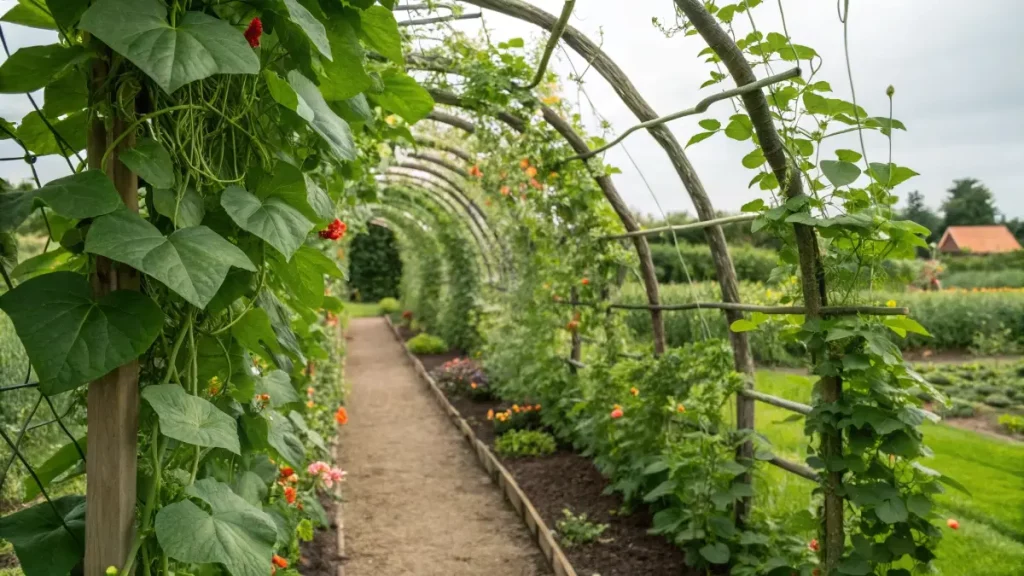
Walkway, canopied by a lush, green archway crafted from climbing vines. The natural tunnel, formed by sturdy wooden supports, is enveloped in vibrant foliage, with splashes of orange and red flowers adding bursts of color along its length.
This inventive garden feature serves as both a beautiful focal point and a productive growing space for vining vegetables or ornamental climbers. Sunlight filters through the leaves, dappling the earthy path below and creating a tranquil atmosphere.
Along the sides of the path, various plants grow in neat rows, hinting at a diverse and thriving garden beyond the arch. This design truly showcases how vertical gardening can transform a simple pathway into an engaging and fruitful part of your outdoor space, blending beauty with botanical bounty.
5. Rows are for Farms
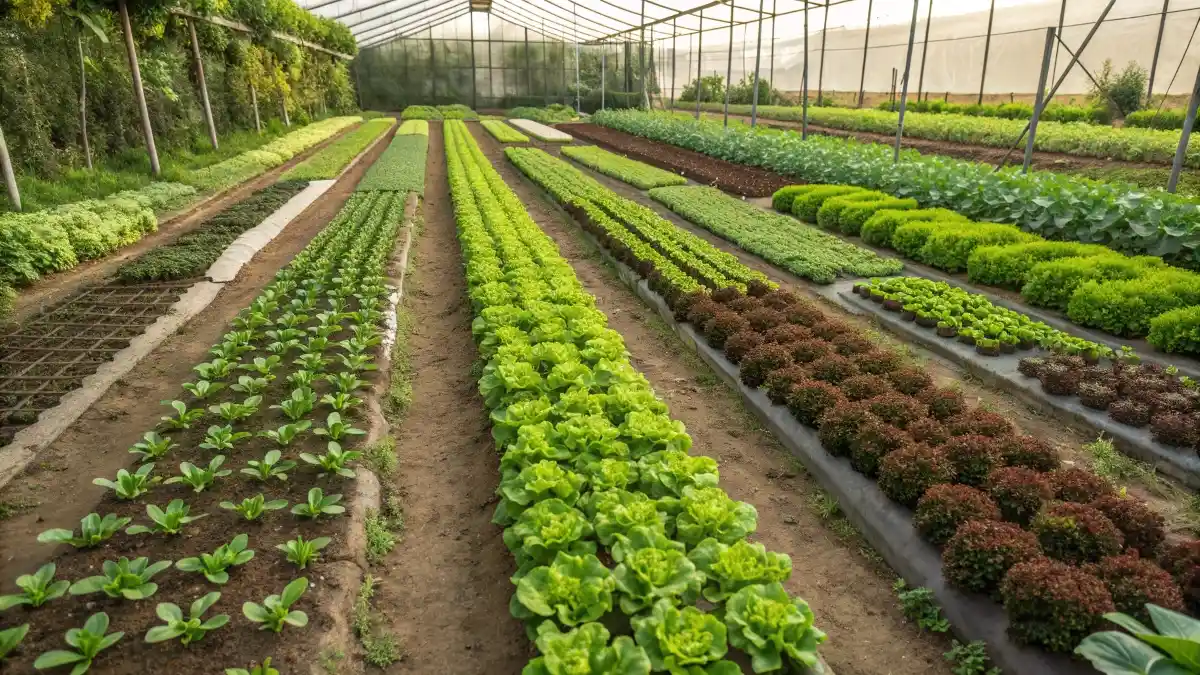
Organized beauty within a bustling greenhouse, showcasing numerous rows of thriving young vegetable plants. Under the protective arch of the structure, various shades of green and reddish-brown foliage create a stunning tapestry of cultivation.
You can observe neatly planted seedlings in the foreground, with healthy heads of lettuce and other leafy greens extending into the distance. This controlled environment allows for extended growing seasons and protection from harsh weather, making it a powerful tool for consistent production.
The even spacing and clear pathways demonstrate careful planning and maintenance. Beyond the immediate rows, more plants are visible, hinting at the extensive scale of this operation.
This scene highlights the advantages of greenhouse gardening for ensuring a steady supply of fresh produce, regardless of the outdoor climate. It’s a testament to modern agricultural efficiency and dedication.
6. Compact Container Crops
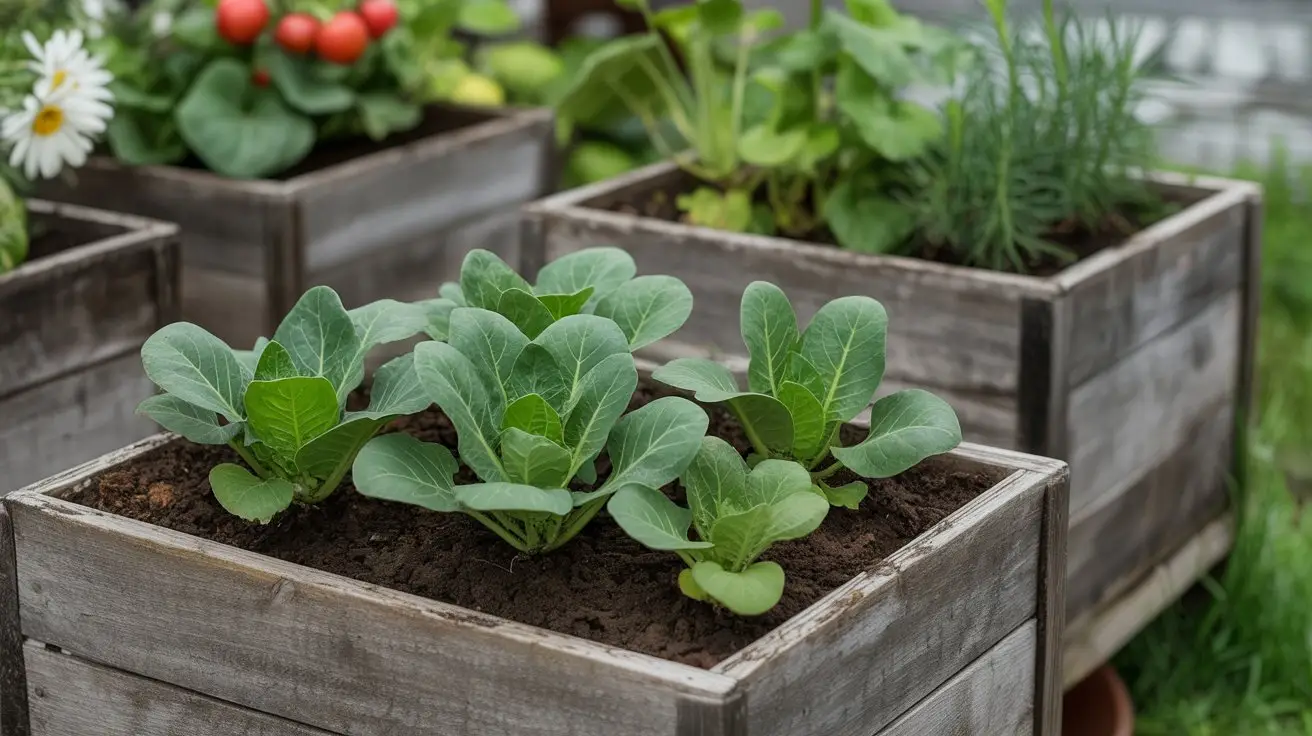
Collection of robust wooden container gardens, each brimming with vibrant plant life. In the foreground, several young, healthy cabbage seedlings with their characteristic broad, green leaves are thriving in rich, dark soil.
These individual wooden boxes offer a flexible and attractive way to cultivate vegetables, herbs, and even flowers, making gardening accessible even in smaller spaces like patios or balconies.
Behind the cabbages, another container holds small, ripe red tomatoes alongside a cheerful white daisy, adding a splash of color and demonstrating the versatility of container planting.
Further back, more planters are visible, suggesting a variety of crops are growing, from leafy greens to fragrant herbs. This setup proves that a bountiful harvest can be achieved with thoughtful container choices, bringing the joy of homegrown produce to any setting.
7. Galvanized Goodness: Portable Vegetable Pots
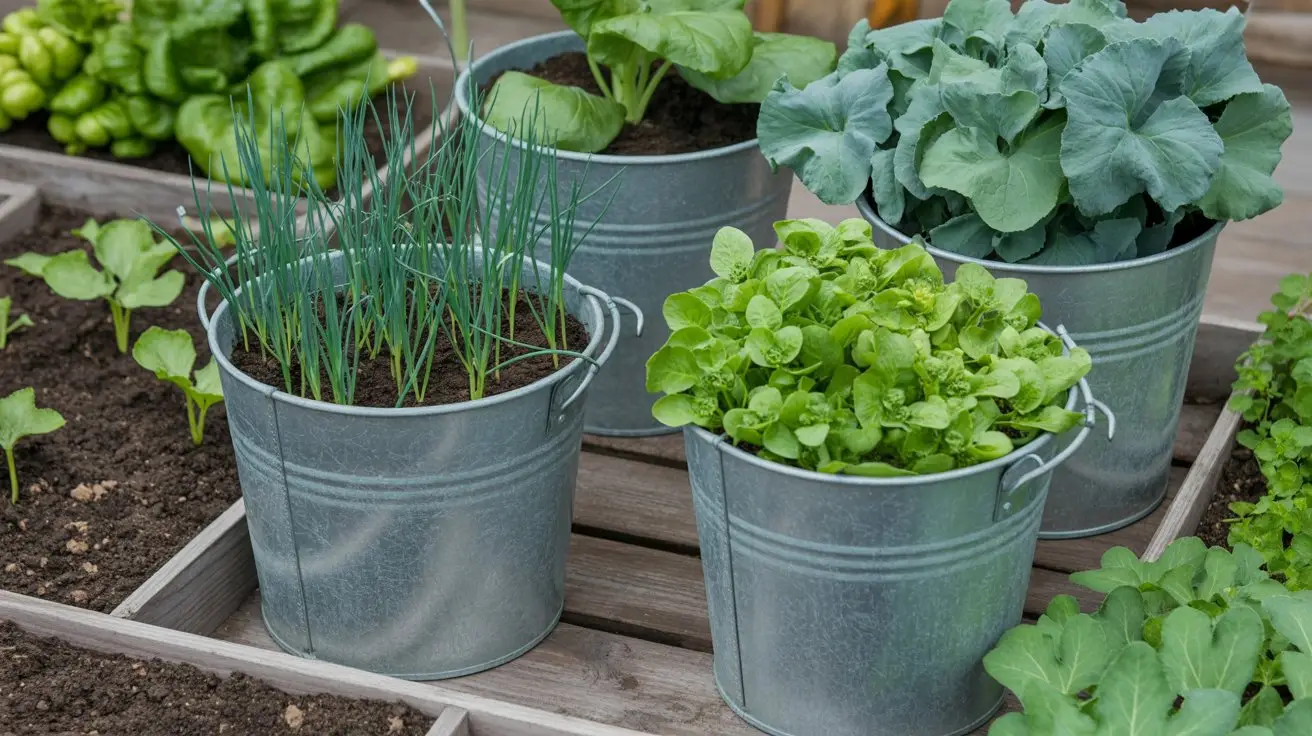
Clever and stylish approach to vegetable gardening using galvanized metal buckets as planters. In the foreground, vibrant green chives or green onions stand tall in one bucket, their slender blades reaching upwards.
Next to them, a second bucket brims with young, tender lettuce leaves, displaying a lighter shade of green. Behind these, larger leafy greens, possibly kale or collards, flourish in another metal container, their robust leaves showing great vigor.
These durable, portable planters sit neatly on a wooden deck, making them an excellent choice for small spaces like patios, balconies, or even urban rooftops. This method allows gardeners to easily move plants to capture the best sunlight or protect them from adverse weather.
The metal buckets offer a rustic yet modern aesthetic, blending functionality with a touch of farmhouse charm, all while growing fresh produce.

